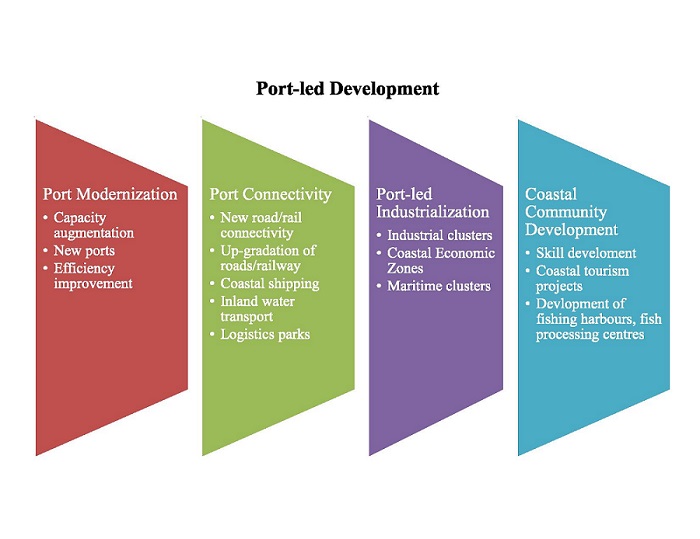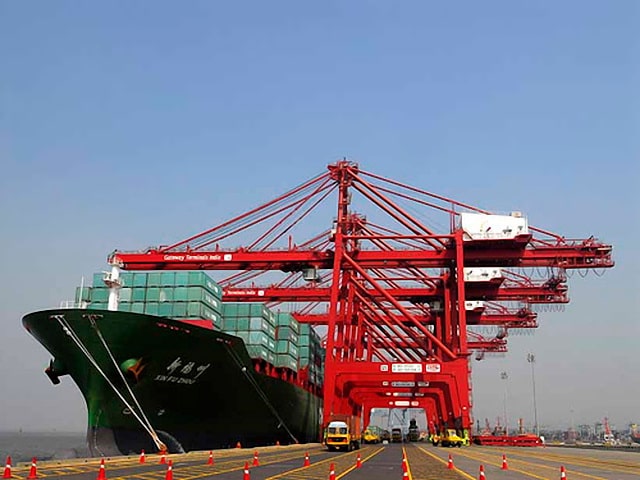Ports infrastructure is key to development of any nation. India has a coastline spanning about 7,500 km. Around 90 percent of India’s external trade by volume and 70 percent by value are handled by ports. Imports of crude petroleum, iron ore, coal, and other essential comamodities are all through the sea route. Twelve major ports and 205 non-major ports operate on India’s coast.
Concerns of Ports Infrastructure
Despite being the most cost-effective and efficient mode, water transport accounted for 6 percent of freight transport in India in 2016-17. Inland Water Transport (IWT) carries less than 2 percent of India’s organized freight traffic and negligible passenger traffic.

Port-led development
Port-led development refers to the development of port infrastructure as well as the linkages between the port and the hinterland area. This model of regional industrial and infrastructural development centers on the development of ports. Ports with high capacities to handle import/export of goods with low turn-around time and fast clearances are essential to usher in port-led development.
Significance of Port-led development
One of the parameters of ease of doing business is the ease of trading across borders. To improve the ease of trading across borders, port-led development is crucial.
Developing ports enables efficient and cost-effective import and export. For this, India needs
to develop major transshipment ports, provide last-mile connectivity to ports, develop linkages with new regions, and enhance multi-modal connectivity with ports.
Issues constraining the growth of ports infrastructure
Shipping and inland water – accounts for a minuscule modal share (6 percent) despite it being the most cost-effective and efficient mode.
Most Indian container handling ports lack the capability to handle large container vessels due to inadequate depth; a minimum draft depth of 18 meters is needed to enable mother vessels to dock at ports.
Weak hinterland connectivity between production centers and gateway ports often leads to higher costs and delays because of sub-optimal mode choices.
- India’s infrastructure generally is in a bad shape and port development is not an exception.
- For the development of ports, India needs huge investment and rapid economic growth. However, due to a decrease in saving, and investment rates, the development of ports does not get enough investment.
- Port facilities in India have been uneconomic, with a lack of easy financing options for private sector investment.
- Delay in getting government approvals, environmental clearances, and compliance with coastal regulations.
- India has built many new ports but the port facilities do not match with global standards, loopholes such as inadequate cargo-handling equipment and machinery, insufficient dredging capacity, lack of technical expertise, etc. still persists.
- The poor connectivity of ports to the hinterland of India make them inefficient.
Government initiatives
Sagarmala program
It focuses on modernizing and developing ports, enhancing port connectivity, supporting coastal communities, and stimulating port-linked industrialization. Sagarmala aims
to reduce the logistics costs for foreign and domestic trade. It also aims to double the share of water transportation in the modal mix.
Jal Marg Vikas project
Jal Marg Vikas Project (JMVP) is a project for the development of National Waterways in India. JMVP was implemented as an initiative towards national integration with an aim to reduce rail and road congestion, carbon footprint, and minimal resource depletion.
Central Road and Infrastructure Fund
The Ministry of Finance has amended the Central Road Fund Act, 2000 to include a list of projects
and infrastructure sub-sectors, including inland waterways, for which the CRF could be used. The
CRF has since been renamed the Central Road and Infrastructure Fund.
Way forward
The government needs to open up the dredging market to attract more players, particularly international players, in dredging activities to increase and maintain draft depth at ports to attract large vessels and enable them to become hub ports.
Expedite the completion of various projects under Sagarmala, especially those aimed at improving port connectivity, setting up coastal economic zones (CEZs), and establishing new ports.
Financing for inland vessels could be made part of priority sector lending by banks.
The setting up of a single-window facility for cargo clearance and putting in place fully mechanized cargo handling infrastructure will be critical to increase throughput.
Enhance technology use in ports and, wherever feasible, draw lessons from successful global ports such as Rotterdam, Felixstowe, and Singapore to improve efficiency.
The new Merchant Shipping Bill to replace the Merchant Shipping Act, 1958, needs to be enacted at the earliest to promote the ease of doing business, transparency, and effective delivery of services. The opening up of the sector will improve the availability of ships and help reduce costs.
IWT should be integrated into multimodal/ intermodal connectivity. Inland terminals with proper road and/or rail connectivity and the seamless transfer of goods from one mode to the other is important for an efficient logistics supply chain.

